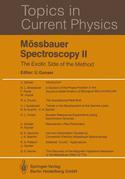Description
Mössbauer Spectroscopy II, Softcover reprint of the original 1st ed. 1981
The Exotic Side of the Method
Topics in Current Physics Series, Vol. 25
Coordinator: Gonser U.
Language: English
Subject for Mössbauer Spectroscopy II:
Mössbauer Spectroscopy II
Publication date: 07-1981
Publication date: 07-1981
Mössbauer Spectroscopy II
Publication date: 04-2014
198 p. · 17x24.4 cm · Paperback
Publication date: 04-2014
198 p. · 17x24.4 cm · Paperback
Description
/li>Contents
/li>
Some newly discovered effects lose their glamor after a short period of euphoria. Others, however, retain their fascination for a long time and, even as they mature, display unexpected features. The Mossbauer effect belongs to the second category. Rudolf Mossbauer's discovery of recoilless gamma-ray emission in 1957 immediately caused a flurry of attention, and confirming work appeared almost at once. Since then the flow of publications has steadily increased. Most studies follow predict abl e paths; the essential aspects of these "conventional" experiments have been described in the first volume of the present work (Mossbauer Spectroscopy, Topics in Applied Physics, Vol. 5). These straightforward investigations have not, however, exhausted the field, boredom has not set in, and unexpected applications continue to appear. In the present volume, Uli Gonser has collected contributions that display the "exotic" side of the Mossbauer effect. They range from a masterly de scription of the red-shift experiment to a clear exposition of a powerful solution to the old and painful phase problem in crystallography. Each of the contributions exhibits a different side of recoilless gamma-ray emission. Together they show that the field is very much alive and continues to delight us with elegant solutions to old problems, unanticipated glimpses at new phenomena, clever uses of new technical possibilities, and ingenious applications to fields far away from physics. I believe that novel features of the Mossbauer effect will continue to appear and that new applications will still be found.
1. Introduction.- 2. A Solution of the Phase Problem in the Structure Determination of Biological Macromolecules.- 3. The Gravitational Red-Shift.- 4. Trends in the Development of the Gamma Laser.- 5. Nuclear Resonance Experiments Using Synchrotron Sources.- 6. Resonance ?-Ray Polarimetry.- 7. Iron-Ion Implantation Studied by Conversion-Electron Mössbauer Spectroscopy.- 8. Selected “Exotic” Applications.- 9. The Discovery of the Magnetic Hyperfine Interaction in the Mössbauer Effect of 57 Fe.
© 2024 LAVOISIER S.A.S.
These books may interest you

Mössbauer Effect Methodology 52.74 €



